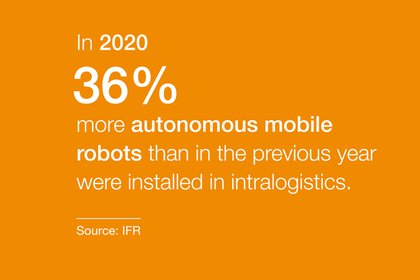The future of work
Humans and machines, not humans vs. machines
What does the future of work look like? Will the robots take over? Are there still going to be people in factories? There certainly will be – smart factories around the globe prove it. The cooperation between humans and machines is already a well-established model for success. It’s a trend on the rise. Because robots are increasingly easy to operate, making them more and more attractive for SMEs and entirely new fields of application.

A new dimension in human-machine interaction
Industry 4.0 and the widespread use of artificial intelligence across all sectors and applications will cause major disruptions in the professional world. This is unsettling news to many people. A look back to the times when robots were considered job killers proves that there is no reason to worry. Today – decades later – the situation is quite different: The countries with the largest robot populations, including Germany, are enjoying low unemployment levels and positive labor market trends.
The cobots are coming
Even smart robots will not make humans obsolete. Instead, smart factories offer interesting new job descriptions to their employees. And automatica presents this work of the future. Cobots make a good example: Many exhibitors use typical demo applications – such as assembly processes or handling tasks – to show how easy it is to operate a collaborative robot these days. See for yourself: Anyone who has attended a short briefing can operate the easy-to-use cobots with their smart gripping systems.
No-code robotics – as easy as programming gets
No-code robotics is yet another trend proving that reservations against handling a robot are just as irrational as doubting one’s own qualifications. Pen-based programming is a good example of how programming is becoming child's play. Here, the user simply draws the robot travel path with a so-called Tracepen – that’s it.
In addition, automatica is an opportunity for you to get informed about visionary approaches to programming, such as gesture and voice control. One thing is for sure: It won’t be long now until robot programming becomes as easy as using a smart phone.
Service robots as well as mobile robotic systems and AGVs (autonomous guided vehicles) make additional contributions to humanization efforts in work environments. automatica will clearly demonstrate that the scope of application of such devices is now almost unlimited. Be it networked digital factories or nursing homes: These mobile service providers relieve people from strenuous physical work and lead to new and very exciting job descriptions for employees.
Digital progress generates exciting job descriptions
The outlook exhibitors will provide in Munich clearly shows one thing: Work in and beyond industrial environments will be much more versatile, interesting, and less physically strenuous in the future. In addition, fully networked digital production infrastructure and AI-optimized processes can help tackle the lack of specialists and further accelerate the relocation of production facilities from low-income countries back to Europe. Such reshoring efforts have become particularly attractive due to the decreasing impact of labor costs as a result of high automation levels. And they reduce dependencies while creating new jobs and reliable supply chains.
Further topics
Community newsletter subscription
what's up by automatica informs you about everything that occupies, excites and inspires the industry: from exciting insights and innovative applications to relevant market trends.


